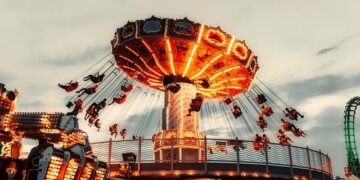As winter nights grow longer and darker, the mesmerizing dance of the Northern Lights once again captures the attention of stargazers and science enthusiasts alike. Tonight, First Alert 4 brings you an in-depth look at the science behind this breathtaking natural phenomenon, explaining how charged solar particles interact with Earth’s atmosphere to create the vibrant auroras visible near the poles. In addition, meteorologists have issued a special Wednesday night aurora forecast, highlighting optimal viewing conditions and the likelihood of spectacular displays across northern regions. Stay tuned as we explore what causes the Northern Lights and what to expect in tonight’s celestial show.
Understanding the Science Behind the Northern Lights
The enchanting light display known as the Northern Lights, or Aurora Borealis, results from a remarkable interaction between solar winds and Earth’s magnetic field. When charged particles emitted by the sun collide with gases in the Earth’s atmosphere, these collisions excite atmospheric molecules, leading to the luminous colors that dance across polar skies. The most common hues-green, pink, and red-arise when oxygen and nitrogen atoms are energized at varying altitudes, creating the celestial spectacle admired worldwide.
Key factors influencing the aurora include:
- Solar activity: Intense solar flares and coronal mass ejections increase the influx of charged particles.
- Earth’s magnetic field strength: The geomagnetic poles act like funnels directing particles toward polar regions.
- Atmospheric composition: Variations in oxygen and nitrogen at different altitudes dictate the colors and intensity of the lights.
| Altitude (km) | Dominant Gas | Typical Color |
|---|---|---|
| 90-150 | Nitrogen | Blue and Purple |
| 150-300 | Oxygen | Green |
| 300+ | Oxygen | Red |
What to Expect from Wednesday Night’s Aurora Forecast
Wednesday night promises a captivating display for aurora chasers, with solar wind speeds anticipated to reach between 450 and 550 km/s. This uptick in solar activity is fueling a moderate geomagnetic storm, making the auroras potentially visible further south than usual. Skywatchers in northern states should prepare for vibrant curtains of green and hints of red shimmering across the horizon, especially after 10 PM local time when the Earth’s magnetic field interaction peaks. Cloud coverage remains a wildcard, but clear patches are expected according to latest satellite imagery.
For those planning to catch the spectacle, here’s what to expect:
- Intensity: KP index projected to hit 5, indicating strong auroral activity.
- Visibility: Best views between 10:00 PM and 2:00 AM in northern latitudes.
- Colors: Predominantly green with possible reds and purples at peak moments.
- Location Tips: Dark, open areas away from city lights offer optimal sighting conditions.
| Time (Local) | Solar Wind Speed (km/s) | KP Index |
|---|---|---|
| 9 PM | 450 | 4 |
| 11 PM | 530 | 5 |
| 1 AM | 550 | 5 |
| 3 AM | 480 | 3 |
Tips for Spotting the Aurora and Staying Safe Outdoors
When venturing outdoors to catch a glimpse of the aurora, timing and location are crucial. Choose a night with clear, dark skies away from city lights to enhance visibility. Keep an eye on the aurora forecast and local weather reports before heading out, as sudden cloud cover can obscure the display. Wear multiple layers to stay warm, as temperatures can plunge rapidly in Northern climates, especially overnight. Don’t forget essentials like a headlamp with a red light setting, which preserves night vision without disturbing fellow watchers. Additionally, bringing a thermos with a warm beverage helps maintain body heat and comfort during long waits.
Safety should be a top priority during your aurora hunt. Always let someone know your plans, including your location and expected return time. If possible, head out with a group rather than alone. Check for trail conditions and avoid risky terrains, such as icy paths or dense forests. The table below highlights basic gear recommendations to prepare for an aurora night:
| Item | Purpose | Recommended Type |
|---|---|---|
| Clothing | Stay warm | Insulated jackets, thermal layers |
| Lighting | Safe navigation | Headlamp with red light mode |
| Communication | Emergency contact | Fully charged phone, portable power bank |
| Footwear | Traction and warmth | Waterproof insulated boots |
By preparing appropriately and taking basic precautions, you can enjoy the breathtaking celestial show while minimizing risks. Remember: respect the natural environment and local regulations, ensuring that everyone can safely share the wonder of the Northern Lights.
To Conclude
As the solar winds continue to interact with Earth’s magnetic field, residents and skywatchers alike are advised to stay alert for the best chances to witness the spectacular northern lights this Wednesday night. Keep an eye on updates from First Alert 4, as shifting conditions could influence the aurora’s visibility across the region. Whether a seasoned observer or a curious newcomer, this celestial light show offers a rare opportunity to connect with the natural wonders unfolding above us.































